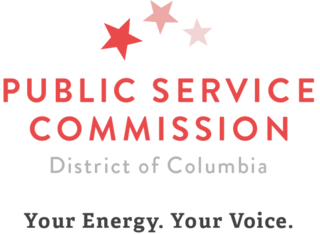
The Federal Energy Regulatory Commission (FERC) is the United States federal agency that regulates the transmission and wholesale sale of electricity and natural gas in interstate commerce and regulates the transportation of oil by pipeline in interstate commerce. FERC also reviews proposals to build interstate natural gas pipelines, natural gas storage projects, and liquefied natural gas (LNG) terminals, in addition to licensing non-federal hydropower projects.

The State Corporation Commission, or SCC, is a Virginia (USA) regulatory agency whose authority encompasses utilities, insurance, state-chartered financial institutions, securities, retail franchising, and railroads. It is the state's central filing office for corporations, limited partnerships, limited liability companies and Uniform Commercial Code liens.

The California Public Utilities Commission is a regulatory agency that regulates privately owned public utilities in the state of California, including electric power, telecommunications, natural gas and water companies. In addition, the CPUC regulates common carriers, including household goods movers, passenger transportation companies such as limousine services, and rail crossing safety. The CPUC has headquarters in the Civic Center district of San Francisco, and field offices in Los Angeles and Sacramento.
The Public Utilities Commission of Ohio (PUCO) is the public utilities commission of the U.S. state of Ohio, charged with the regulation of utility service providers such as those of electricity, natural gas, and telecommunications as well as railroad safety and intrastate hazardous materials transport.

The District of Columbia Public Service Commission is an independent quasi-judicial body and regulatory agency responsible for regulating landline telephone, electricity, and gas utility companies operating within the District of Columbia. It was established by the US Congress in 1913.

The Oklahoma Corporation Commission is the public utilities commission of the U.S state of Oklahoma run by three statewide elected commissioners. Authorized to employ more than 400 employees, it regulates oil and gas drilling, utilities and telephone companies.
The Florida Public Service Commission (FPSC) regulates investor-owned electric, natural gas, and water and wastewater utilities. The FPSC facilitates competitive markets in the telecommunications industry, has authority over intercarrier disputes, and oversees pay telephones, the federal Lifeline Assistance Program and Telecommunications Relay Service.

The California Energy Commission, formally the Energy Resources Conservation and Development Commission, is the primary energy policy and planning agency for California.
The Southern Maryland Electric Cooperative (SMECO) is an electric distribution cooperative which is headquartered in Hughesville, Maryland, United States. SMECO serves approximately 161,000 customers in Calvert, Charles, Prince George's, and St. Mary's counties of southern Maryland. Under its rules as a nonprofit cooperative, SMECO passes on its costs to its customer-members without markup or profit.

The Arizona Corporation Commission is the Public Utilities Commission of the State of Arizona, established by Article 15 of the Arizona Constitution. Arizona is one of only fourteen states with elected commissioners. The Arizona Constitution explicitly calls for an elected commission, as opposed to a governor-appointed commission, which is the standard in most states, because its drafters feared that governors would appoint industry-friendly officials. They are directly elected statewide and serve staggered four-year terms. Due to its separation from the executive branch, the commission is often referred to as the "fourth branch of government." The characterization of the Commission as the "fourth branch of government" is contradicted, however, by Article III of the Arizona Constitution, which provides that "[t]he powers of the government of the state of Arizona shall be divided into three separate departments, the legislative, the executive, and the judicial".

William Ashbie Hawkins (1862–1941) was a lawyer in Baltimore, Maryland, who litigated prominent civil rights cases. One of Baltimore's first African American lawyers, he was born in Lynchburg, Virginia, on August 2, 1862, to Reverend Robert and Susan Cobb Hawkins. One of Hawkins grandsons, Cromwell Ashbie Hawkins West, fabricated a Native American identity for himself and went by the name "Red Thunder Cloud".
Entergy Louisiana, Inc. v. Louisiana Public Service Commission, 539 U.S. 39 (2003), is a Supreme Court of the United States case holding that a federal administrative agency approved public utility tariff preempted a state public utilities commission rate order under the filed rate doctrine.
Pennsylvania Public Utility Commission (PUC) is the public utility commission in Pennsylvania. It is composed of five commissioners, appointed by the Governor with the consent of the state Senate. The PUC oversees public utility and services operations in the commonwealth, in sectors including water, energy, telecommunications, and transportation.
The Georgia Public Service Commission (PSC) is a statutory organ of the state government of Georgia; elected among five commission districts, the board consists of a Chairman, a Vice-chairman, and three Commissioners. PSC regulates telecommunications, transportation, electric and natural gas services in the U.S. state of Georgia. Commissioners are elected in partisan elections statewide, though they must reside in a district.
The Montana Public Service Commission (PSC) is a quasi-judicial regulatory board of elected officials in the U.S. state of Montana.
The Public Service Commission of Wisconsin is an independent regulatory agency responsible for regulating public utilities in the energy, telecommunications, gas and water companies located in U.S. state of Wisconsin. As of 2021, the agency regulated more than 1,100 electric, natural gas, telephone, water, and water/sewer utilities.

The New York Public Service Commission is the public utilities commission of the New York state government that regulates and oversees the electric, gas, water, and telecommunication industries in New York as part of the Department of Public Service. The department's regulations are compiled in title 16 of the New York Codes, Rules and Regulations. The current chairman of the Commission and chief executive of the Department is Rory M. Christian. His term began on June 10, 2021 and runs through February 1, 2027.

The Mississippi Public Service Commission is a government agency which regulates telecommunications, electric, gas, water and sewer utilities in the U.S. state of Mississippi. It is led by three commissioners, with one commissioner elected by voters in each of the state's three Supreme Court districts. Commissioners are elected to four year terms in the general election of the same year that other state and county officials are chosen. The current commissioners are Brandon Presley, Brent Bailey and Dane Maxwell.
The Two Creeks Solar Park is a 150 MW solar photovoltaic energy station in Manitowoc County, Wisconsin. Ownership is shared between Wisconsin Public Service Corporation (WPS) and Madison Gas and Electric (MG&E), at 100 MW and 50MW, respectively. It was the first utility-scale solar plant approved and constructed in Wisconsin.
The Badger Hollow Solar Farm is a 300 MW solar photovoltaic energy station currently in construction in Iowa County in southwestern, Wisconsin. Ownership is shared between Wisconsin Public Service Corporation (WPS), Madison Gas and Electric (MG&E), and Wisconsin Electric Power Company, with each utility owning 100 MW. It was the second utility-scale solar plant approved and constructed in Wisconsin










